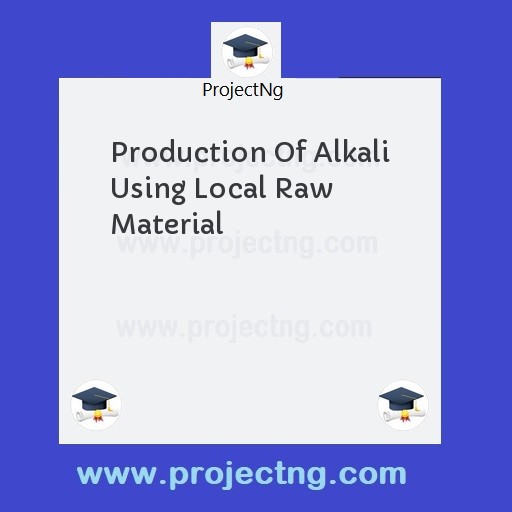Production Of Alkali Using Local Raw Material
Chemical Engineering Project Topics
Get the Complete Project Materials Now! »
PRODUCTION OF ALKALI USING LOCAL RAW MATERIAL
ABSTRACT
The project aims to develop a flow process to obtain the optimum temperature and time necessary for the maximum recovery of alkali present in palm inflorescence.
On this ground, a preliminary experiment was performed. During this process, both male and female palm inflorescence were compared for maximum alkali production and it was observed that the female palm inflorescence produced highest quantity of alkali than the male palm inflorescence. Based on this, the female palm inflorescence was used in performing the experiment.
Also, experiments were carried out to determine the optimum temperature and time for maximum alkali recovery. After the analysis and analytical calculations it was found that the optimum temperature for maximum alkali production is 4500c and the corresponding time for the production is 90 minutes.
TABLE OF CONTENT
Title page
Letter of transmittal
Dedication
Acknowledgement
Abstract
Table of content
1.0 CHAPTER ONE
INTRODUCTION
1.1 Need for local production of Alkali
2.0 CHAPTER TWO -
LITERATURE REVIEW
2.1 Oil palm tree (description)
2.1.1 Classification of palm and location
2.1.2 Oil palm: Historical review
2.2 Palm inflorescence
CHAPTER THREE
3.0 Experimental procedure
CHAPTER FOUR
Experimental results
CHAPTER SIX
Conclusion
CHAPTER SEVEN
Recommendation
References
CHAPTER EIGHT
Appendixes
CHAPTER ONE
Over the years, alkali has been of prime importance as raw material both for industrial and laboratory purpose. Alkali as a word was derived from an erabic word, which mean ashes. Ashes could be wood ashes, Ngu ashes or any other type of ash sourced by burning a given material. Alkali is said to be the basic hydroxide, which is soluble in water.
The compounds of alkali metals are so soluble that they tend to be leached out of the soil by rainwater end hence carried by streams and rivers to the sea. Based on this, sea water contain about three percent (3%) by weight of alkali salts.
Alkalis are produced both industrially end locally. The local production is mainly by the use of palm inflorescence or plantain peels. It involved burning of the palm inflorescence and subsequently leaching out of the alkali with water. When the produced alkali is sourced, potassium hydroxide is much in quantity then sodium hydroxide. About 45% of alkali is obtained using the female palm inflorescence of the oil palm tree.
The quality of the leachate obtained depends on the following.
i. Ashing condition
ii. Solvent used
iii. The type of plant ash used
iv. Method of leaching
One of the major raw materials for soap production is alkali. The alkali may be a hydroxide, a carbonate of hydrogen carbonate. The cations most commonly used are those of sodium and potassium. At the time of saponification, they denote metal ions, which form soap with fatty acid. Hence
![]() 0
0
![]() H2 C - C OR1
H2 C - C OR1
![]() 0
0
![]() H C - C - OR11 + 3xY 3RC00x + CH2 Y
H C - C - OR11 + 3xY 3RC00x + CH2 Y
CH2 Y
H2 C - C - OR111 CH2 Y
Where x is a metal ion
Many of the alkali has gained wide application some of them are sodium hydroxide (Na0H), sodium carbonate (Na0 C03), potassium hydroxide (KOH), sodium hydrogen carbonate and potassium hydrogen carbonate (KHC03).
THE OBJECTIVES OF THE PROJECT RESEARCH
i. Establishment of the best and optimum method of producing high quality alkali locally.
ii. Development of a flow process to obtain the optimum temperature and time needed for the maximum recovery of the high quality alkali and specification of its concentration at this optimum condition.
iii. Preparation of the detailed process flow diagram.
1.1 SIGNIFICANCE OF THE RESEARCH
It is important to state that production of alkali locally is very much encouraged. This is because soap which is one of the numerous products produced by the use of alkali finds extensive usage both in domestic and other general laundry activities.
In order to sustain the industry in dear need of alkali as a major raw material, there is the need that alkali should be locally produced, more especially at this period of time that the federal government has placed ban on importation of some of the basic raw materials needed in soap and soap related industries.
For there to be continuity of these industries, alkali which is a major raw material must be source locally. This can be obtained by the use of palm inflorescence of oil palm (Eleasis Guineasis). The production of alkali through this means, makes 17 possible for soap industries and other related industries to obtain one of their major raw materials.
Owing to the fact that this production process is relatively cheap, it prevents the expenses incurred in the importation of alkali for soap production and other uses which subsequently reduces the cost of the final products. Hence, this research project is geared towards harnessing the somewhat neglected Nigerian’s agricultural prowess in the preservation of the vest palm trees found in her rich forest, and then make appropriate use of its palm inflorescence in the production of alkali.
Be the First to Share On Social

Enjoying our content?
Don't miss out on new videos! Subscribe to our YouTube channel for more awesome content.
Subscribe Now!













